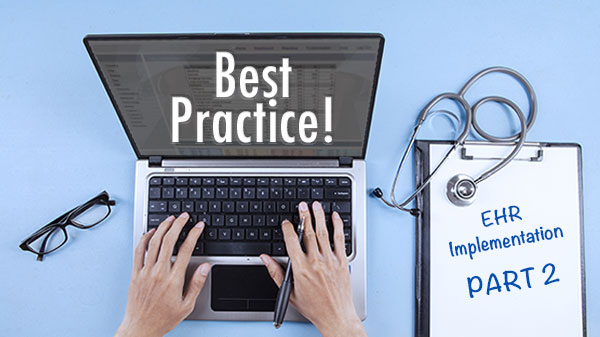EHR Implementation Mistakes to Avoid, Part 2
So, you think you’ve settled on a new EHR system for your practice? Perhaps you’re a late-adopter and this is your first dive into the EHR world; or perhaps you’ve had an EHR for some time and it just wasn’t working for your office, thus making a switch. In either case, it’s important to ground yourself and approach the purchasing and implementation process with a level head. We recommend setting goals ahead of time and establishing metrics for success, so you get yourself the right product for you, and don’t just get swept up in the “sales” of it all. We touched on all of this in our prior blog, EHR Implementation Mistakes to Avoid, part 1!

Another thing that we recommend is to pay careful attention to the vendor. How’s their reputation? Do they have good reviews either online or from other similar practices? See if you can identify the quality of their customer service, training and implementation. Any vendor will be happy to sell you the product in the first place, but a good long-term partner for your practice will guide you through the implementation process and be available for support down the line. There’s no such thing as a perfect system, and even if it seems to work great during the demo, you will inevitably run into an issue that you can’t fix yourself. Will you be able to reach your vendor on the phone or in person for assistance?
On the topic of vendors, it’s also a good idea to take a look at the other products and services that they offer. You may have gone into this just looking to save money and buy a bare-bones EHR system, but there are a number of other related ways you could improve the efficiency and effectiveness of your practice. Perhaps the vendor offers cloud-based storage for all of your files, relieving you of the burden of managing your own server. Perhaps they sell computers and hardware that facilitate taking and filing your records away. Or maybe they’ll offer a different technological service entirely, like managing your reputation online. You needn’t go on a spending spree, and maybe you don’t need any of that right now; but if you like your EHR and the vendor does offer these other services, they are likely to integrate seamlessly into your workflow. Plus, you’ve likely already established a good relationship with them, making that transition even easier.
Before you start thinking about future purchases, though, you would do well to assess the quality of your EHR investment. You should have some metrics and measurable goals going into the launch. These will vary from practice to practice and depends highly on what you expect from your EHR. In general, though, you’ll want to evaluate how your staff’s performance is affected and how your patient’s satisfaction is impacted.
Your staff’s performance can be measured in a few ways. You can measure how long they spend on record filing and data entry tasks now and compare that to your previous workflow. If you do this, though, remember to keep track of their speed improvements over time, perhaps the first three months. Any new software and system will be an impediment at first as you all learn the new processes. The sign of a good EHR and good implementation is that they pick up speed quickly, eventually becoming more efficient than before.
Alternatively, you could ask your staff to fill out brief periodic surveys as the implementation is rolled out. This way you can gather information and feelings that you may not have been able to pick up from observations or measurements. A little grumpiness and resistance to change at first is normal. What you want to know is after 1 week, 1 month, how are their feelings and perceived productivity changing? If it doesn’t start improving eventually, you may need to reconsider EHR products.
A similar survey approach can be taken with patients. There’s no need to frustrate them with long, drawn-out questionnaires, but a few questions about their user experience, wait time, and satisfaction can give you great insight. It can be difficult otherwise to accurately measure a patient’s experience, as new many new faces come and go each day. The other thing to look out for will be online reviews. Tracking positive and negative reviews over time can provide some insight into the effectiveness of your new practices.
Remember, increasing tech in the doctor’s office is intended to improve patients’ healthcare quality, as well as increase efficiency for you (meaning that you can spend less time with day-to-day office tasks). There are monetary incentives to spur that change, but in the end that’s always the goal. If you implement your EHR successfully, you should see the benefits!
If you’d like to read more in-depth information on EHR Implementations you can check out our related EHR Implementation Mistakes to Avoid, part 1.





 QUICK CHARTING
QUICK CHARTING NOTE
NOTE MEDICATION
MEDICATION PATIENT
PATIENT BILLING
BILLING RISK
RISK MARKETING
MARKETING MIPS
MIPS